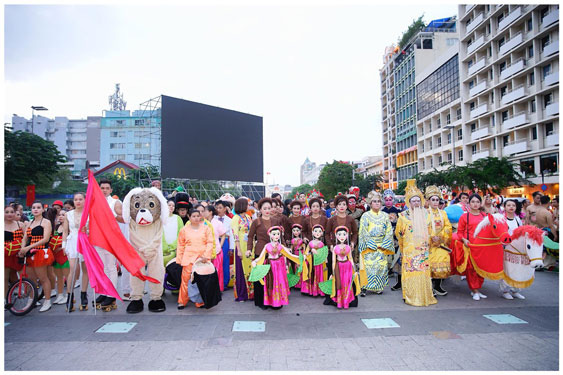 Life & Style
Life & Style

Installation of art in public places in Việt Nam is essential to the development of smart cities and their cultural life, HCM City artists and cultural experts have said.

|
| Nguyễn Huệ Pedestrian Street in HCM City's District 1 hosts many entertainment and cultural activities. Photo courtesy of nld.com.vn |
HCM CITY — Installation of art in public places in Việt Nam is essential to the development of smart cities and their cultural life, HCM City artists and cultural experts have said.
Public art using materials such as wood and plaster began to appear in numerous places in HCM City around 50 years ago. Even though public art works did not gain much attention at the time, they have become more important now that the city has grown significantly.
“About 20 years ago, I sent a proposal to the HCM City People’s Committee and suggested transforming the two sides of Nhiêu Lộc Canal into a statue garden inspired by Hùng Vương (Hùng Kings) and up to the current era,” artist Trang Phượng said.
“I also suggested building bridges that have cultural and artistic values. This proposal is not too expensive, considering that bridges typically have the same structure. However, 20 years have passed and those plans have not been executed,” he added.
As the economy develops, authorities should pay more attention to public art space when carrying out architectural planning, he said. Otherwise, the public would suffer a great cultural loss.
In addition to wall paintings, HCM City has introduced “blooming” electrical poles in which the poles are decorated with paintings of colourful flowers in an effort to encourage locals to save the environment.
However, this has generated mixed opinions among locals.
“HCM City already has a street that sells lights during the Lantern Festival. Hải Thượng Lãn Ông Street is famous for traditional medicine, and Catholic neighborhoods are decorated very beautifully every Christmas season,” said Dr. Lê Hồng Phước from the HCM City University of Social Sciences and Humanities.
He suggested that HCM City should have fixed art spaces for locals to have more cultural activities and visitors to have more options for sightseeing.
“Gia Định Park, where the Phương Nam Art Theatre’s circus is located, could become a park for puppet and circus art, while the alley next to Thủ Đô Theatre could be turned into a space for locals who love the art of hát bội,” he added.
Meritorious Artist and director Ca Lê Hồng said that public artworks reflect various cultural identities of Việt Nam throughout the course of history. Quality public art spaces can improve locals’ artistic sense and enrich their lives, Hồng added.
Experts agreed that public art is not necessarily captured in the form of architectural monuments, but via music festivals and various types of street art.
Authorities should make use of old factories, bus stops, new urban areas, and parks, among other platforms, to install artwork for people to enjoy.
Phước suggested that in addition to Nguyễn Văn Bình Book Street, HCM City should consider making Huyền Trân Công Chúa Street a public art space for local artists in different fields to express their creativity. Public art space is not just about architectural monuments, but creativity in various forms, Phước said. — VNS




